Dynamics of Plant Litter Sodium Storage in a Subtropical Forest Headwater Stream
Abstract
1. Introduction
2. Methods and Materials
2.1. Study Area
2.2. Experimental Design
2.3. Laboratory Analysis
2.4. Statistical Analysis
3. Results
3.1. Dynamics of Stream Litter Na Concentration and Storage
3.2. Factors Affecting Stream Litter Na Storage
4. Discussion
5. Conclusions
Author Contributions
Funding
Data Availability Statement
Conflicts of Interest
References
- Lidman, J.; Jonsson, M.; Burrows, R.M.; Bundschuh, M.; Sponseller, R.A. Composition of riparian litter input regulates organic matter decomposition: Implications for headwater stream functioning in a managed forest landscape. Ecol. Evol. 2017, 7, 1068–1077. [Google Scholar] [CrossRef]
- Tonin, A.M.; Goncalves, J.F., Jr.; Bambi, P.; Couceiro, S.R.M.; Feitoza, L.A.M.; Fontana, L.E.; Hamada, N.; Hepp, L.U.; Lezan-Kowalczuk, V.G.; Leite, G.F.M.; et al. Plant litter dynamics in the forest-stream interface: Precipitation is a major control across tropical biomes. Sci. Rep. 2017, 7, 10799. [Google Scholar] [CrossRef] [PubMed]
- Tank, J.L.; Rosi-Marshall, E.J.; Griffiths, N.A.; Entrekin, S.A.; Stephen, M.L. A review of allochthonous organic matter dynamics and metabolism in streams. J. N. Am. Benthol. Soc. 2010, 29, 118–146. [Google Scholar] [CrossRef]
- Gounand, I.; Little, C.J.; Harvey, E.; Altermatt, F. Cross-ecosystem carbon flows connecting ecosystems worldwide. Nat. Commun. 2018, 9, 4825. [Google Scholar] [CrossRef] [PubMed]
- Hu, W.; Wu, F.; Ni, X.; Peng, Y.; Wang, Z.; Zhao, Z.; Wang, Y.; Yue, K. Dynamics of plant litter storage in a subtropical forest headwater stream during the rainy season. Pol. J. Ecol. 2023, 70, 129–141. [Google Scholar] [CrossRef]
- Pye, M.C.; Vaughan, I.P.; Ormerod, S.J.; Durance, I. Organic litter dynamics in headwater streams draining contrasting land uses. Hydrobiologia 2022, 850, 3375–3390. [Google Scholar] [CrossRef]
- Bruder, A.; Schindler, M.H.; Moretti, M.S.; Gessner, M.O. Litter decomposition in a temperate and a tropical stream: The effects of species mixing, litter quality and shredders. Freshw. Biol. 2013, 59, 438–449. [Google Scholar] [CrossRef]
- Zhang, M.; Cheng, X.; Geng, Q.; Shi, Z.; Luo, Y.; Xu, X.; Morellato, P. Leaf litter traits predominantly control litter decomposition in streams worldwide. Glob. Ecol. Biogeogr. 2019, 28, 1469–1486. [Google Scholar] [CrossRef]
- Shen, X.; Chen, Y.; Wang, L.; Guo, L.; Zheng, H.; Zhang, J.; Xu, Z.; Tan, B.; Zhang, L.; Li, H.; et al. Mixture of plant functional groups inhibits the release of multiple metallic elements during litter decomposition in alpine timberline ecotone. Sci. Total Environ. 2020, 747, 141298. [Google Scholar] [CrossRef]
- Haro, R.; Banuelos, M.A.; Rodriguez-Navarro, A. High-affinity sodium uptake in land plants. Plant Cell Physiol. 2009, 51, 68–79. [Google Scholar] [CrossRef]
- Kronzucker, H.J.; Coskun, D.; Schulze, L.M.; Wong, J.R.; Britto, D.T. Sodium as nutrient and toxicant. Plant Soil 2013, 369, 1–23. [Google Scholar] [CrossRef]
- Wakeel, A.; Farooq, M.; Qadir, M.; Schubert, S. Potassium Substitution by Sodium in Plants. Crit. Rev. Plant Sci. 2011, 30, 401–413. [Google Scholar] [CrossRef]
- Wang, Y.; Wu, F.; Wu, Q.; Yue, K.; Yuan, J.; Yuan, C.; Peng, Y. Global characteristics and drivers of sodium and aluminum concentrations in freshly fallen plant litter. Front. Plant Sci. 2023, 14, 1174697. [Google Scholar] [CrossRef]
- Kominoski, J.S.; Hoellein, T.J.; Kelly, J.J.; Pringle, C.M. Does mixing litter of different qualities alter stream microbial diversity and functioning on individual litter species? Oikos 2009, 118, 457–463. [Google Scholar] [CrossRef]
- Shen, G.; Chen, D.; Wu, Y.; Liu, L.; Liu, C. Spatial patterns and estimates of global forest litterfall. Ecosphere 2019, 10, e02587. [Google Scholar] [CrossRef]
- Oester, R.; Dos Reis Oliveira, P.C.; Moretti, M.S.; Altermatt, F.; Bruder, A. Leaf-associated macroinvertebrate assemblage and leaf litter breakdown in headwater streams depend on local riparian vegetation. Hydrobiologia 2023, 850, 3359–3374. [Google Scholar] [CrossRef]
- Larrañaga, S.; Díez, J.R.; Elosegi, A.; Pozo, J. Leaf retention in streams of the Agüera basin (northern Spain). Aquat. Sci. 2003, 65, 158–166. [Google Scholar] [CrossRef]
- Richardson, J.S.; Hoover, T.M.; Lecerf, A. Coarse particulate organic matter dynamics in small streams: Towards linking function to physical structure. Freshw. Biol. 2009, 54, 2116–2126. [Google Scholar] [CrossRef]
- Ferreira, V.; Lírio, A.V.; Rosa, J.; Canhoto, C. Annual organic matter dynamics in a small temperate mountain stream. Ann. De Limnol.-Int. J. Limnol. 2013, 49, 13–19. [Google Scholar] [CrossRef]
- Shi, T.; Ma, J.; Wu, X.; Ju, T.; Lin, X.; Zhang, Y.; Li, X.; Gong, Y.; Hou, H.; Zhao, L.; et al. Inventories of heavy metal inputs and outputs to and from agricultural soils: A review. Ecotoxicol. Environ. Saf. 2018, 164, 118–124. [Google Scholar] [CrossRef]
- Leroy, C.J.; Marks, J.C. Litter quality, stream characteristics and litter diversity influence decomposition rates and macroinvertebrates. Freshw. Biol. 2006, 51, 605–617. [Google Scholar] [CrossRef]
- Firmano, R.F.; Melo, V.F.; Montes, C.R.; de Oliveira, A.; de Castro, C.; Alleoni, L.R.F. Potassium Reserves in the Clay Fraction of a Tropical Soil Fertilized for Three Decades. Clays Clay Miner. 2020, 68, 237–249. [Google Scholar] [CrossRef]
- Six, L.J.; Bilby, R.E.; Reiter, M.; James, P.; Villarin, L. Effects of current forest practices on organic matter dynamics in headwater streams at the Trask river watershed, Oregon. Trees For. People 2022, 8, 100233. [Google Scholar] [CrossRef]
- Tiegs, S.D.; Akinwole, P.O.; Gessner, M.O. Litter decomposition across multiple spatial scales in stream networks. Oecologia 2009, 161, 343–351. [Google Scholar] [CrossRef]
- Taylor, B.R.; Chauvet, E.E. Relative influence of shredders and fungi on leaf litter decomposition along a river altitudinal gradient. Hydrobiologia 2013, 721, 239–250. [Google Scholar] [CrossRef]
- Jiang, H.; Wu, F.; Zhao, Z.; Ni, X.; Yue, K. Dynamic features of potassium and sodium in subtropical forest headwater stream fine sediments during the rainy season. J. Subtrop. Resour. Environ. 2023, 18, 55–62. [Google Scholar] [CrossRef]
- Yuan, S.Y.; Xu, L.; Tang, H.w.; Xiao, Y.; Gualtieri, C. The dynamics of river confluences and their effects on the ecology of aquatic environment: A review. J. Hydrodyn. 2022, 34, 1–14. [Google Scholar] [CrossRef]
- Zhao, Y.; Chen, X.; Kim, J.S.; Williams, M. Effects of temperature and precipitation on litterfall phenology in four evergreen broad-leaved forests of southern China. Biotropica 2022, 54, 739–753. [Google Scholar] [CrossRef]
- Tan, X.; Shen, W. Advances in the effects of precipitation regime alteration and elevated atmospheric nitrogen deposition on above- and below-ground litter decomposition in forest ecosystems. Acta Ecol. Sin. 2021, 41, 444–455. [Google Scholar] [CrossRef]
- Guan, L.; Zhou, G.; Zhang, D.; Liu, J.; Zhang, Q. Twenty years of litter fall dynamics in subtropical evergreen broad-leaved forests at the Dinghushan forest ecosystem research station. Acta Phytoecol. Sin. 2004, 28, 449–456. [Google Scholar] [CrossRef]
- Follstad Shah, J.J.; Kominoski, J.S.; Ardon, M.; Dodds, W.K.; Gessner, M.O.; Griffiths, N.A.; Hawkins, C.P.; Johnson, S.L.; Lecerf, A.; LeRoy, C.J.; et al. Global synthesis of the temperature sensitivity of leaf litter breakdown in streams and rivers. Glob. Change Biol. 2017, 23, 3064–3075. [Google Scholar] [CrossRef] [PubMed]
- Ferreira, V.; Chauvet, E. Synergistic effects of water temperature and dissolved nutrients on litter decomposition and associated fungi. Glob. Change Biol. 2011, 17, 551–564. [Google Scholar] [CrossRef]
- Ferreira, V.G. Role of physical fragmentation and invertebrate activity in the breakdown rate of leaves. Arch. Für Hydrobiol. 2006, 165, 493–513. [Google Scholar] [CrossRef]
- Ferreira, V.; Guérold, F. Leaf litter decomposition as a bioassessment tool of acidification effects in streams: Evidence from a field study and meta-analysis. Ecol. Indic. 2017, 79, 382–390. [Google Scholar] [CrossRef]
- Wu, D.; Han, Z.C.; Li, W.J.; Tian, A.; Wan, J.G. Study on the decomposition and water holding capacity of flower and leaf litter mixtures of Rhododendron delavayi. J. Soil Water Conserv. 2020, 34, 186–191. [Google Scholar] [CrossRef]
- Yu, W.; Wang, C.; Cornelissen, J.H.C.; Ye, X.; Huang, Z.; Wang, D.; Liu, G. Litter position and stoichiometry regulate plant litter decomposition and nitrogen release in terrestrial ecosystems. Catena 2025, 256, 109093. [Google Scholar] [CrossRef]
- Boyero, L.; Pearson, R.G.; Hui, C.; Gessner, M.O.; Perez, J.; Alexandrou, M.A.; Graca, M.A.; Cardinale, B.J.; Albarino, R.J.; Arunachalam, M.; et al. Biotic and abiotic variables influencing plant litter breakdown in streams: A global study. Proc. R. Soc. B-Biol. Sci. 2016, 283, 2664. [Google Scholar] [CrossRef]
- Li, Y.; Mi, W.; Ji, L.; He, Q.; Yang, P.; Xie, S.; Bi, Y. Urbanization and agriculture intensification jointly enlarge the spatial inequality of river water quality. Sci. Total Environ. 2023, 878, 162559. [Google Scholar] [CrossRef]
- Canedo-Arguelles, M.; Kefford, B.J.; Piscart, C.; Prat, N.; Schafer, R.B.; Schulz, C.J. Salinisation of rivers: An urgent ecological issue. Environ. Pollut. 2013, 173, 157–167. [Google Scholar] [CrossRef]
- Hintz, W.D.; Relyea, R.A. A review of the species, community, and ecosystem impacts of road salt salinisation in fresh waters. Freshw. Biol. 2019, 64, 1081–1097. [Google Scholar] [CrossRef]
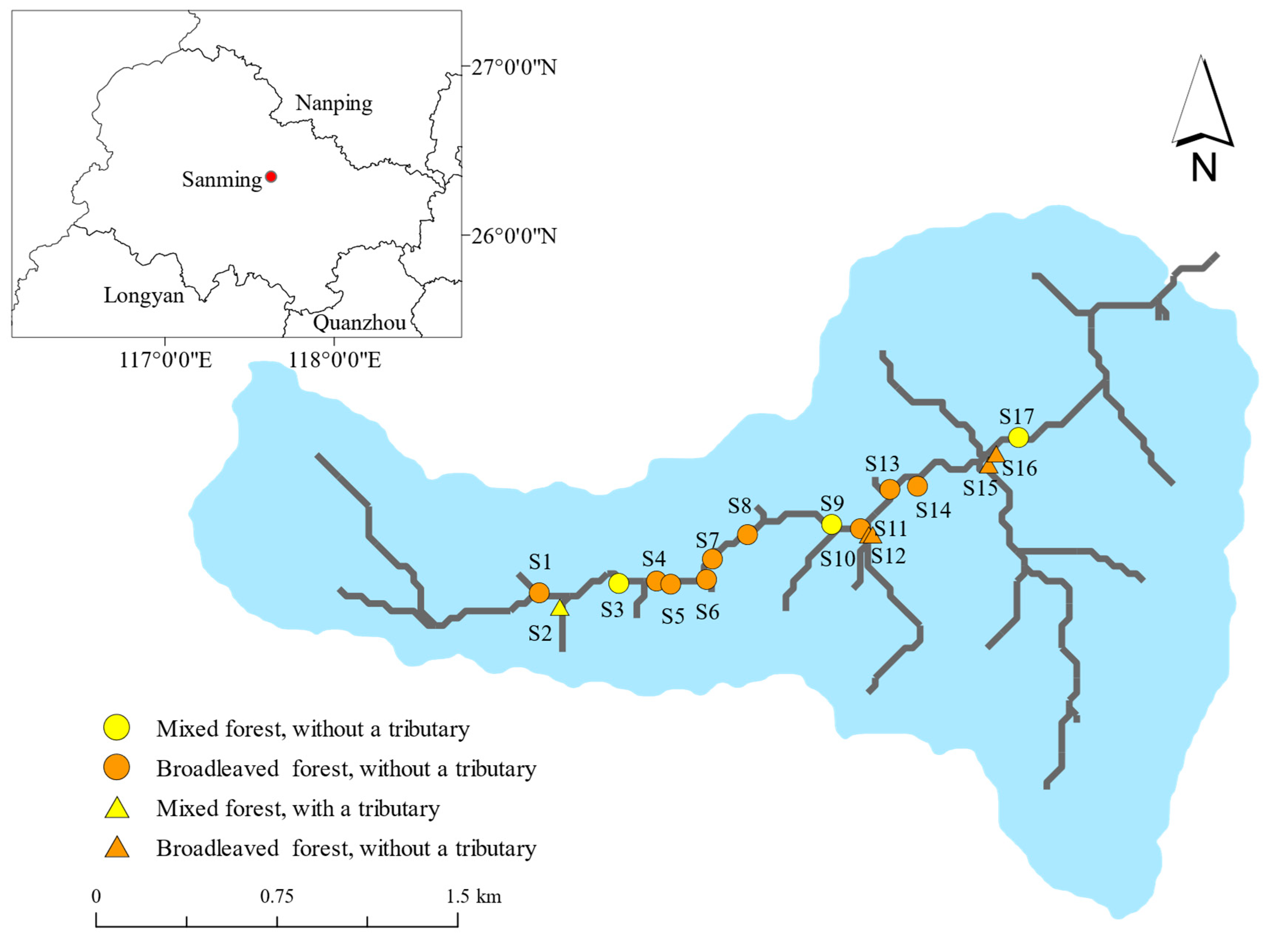
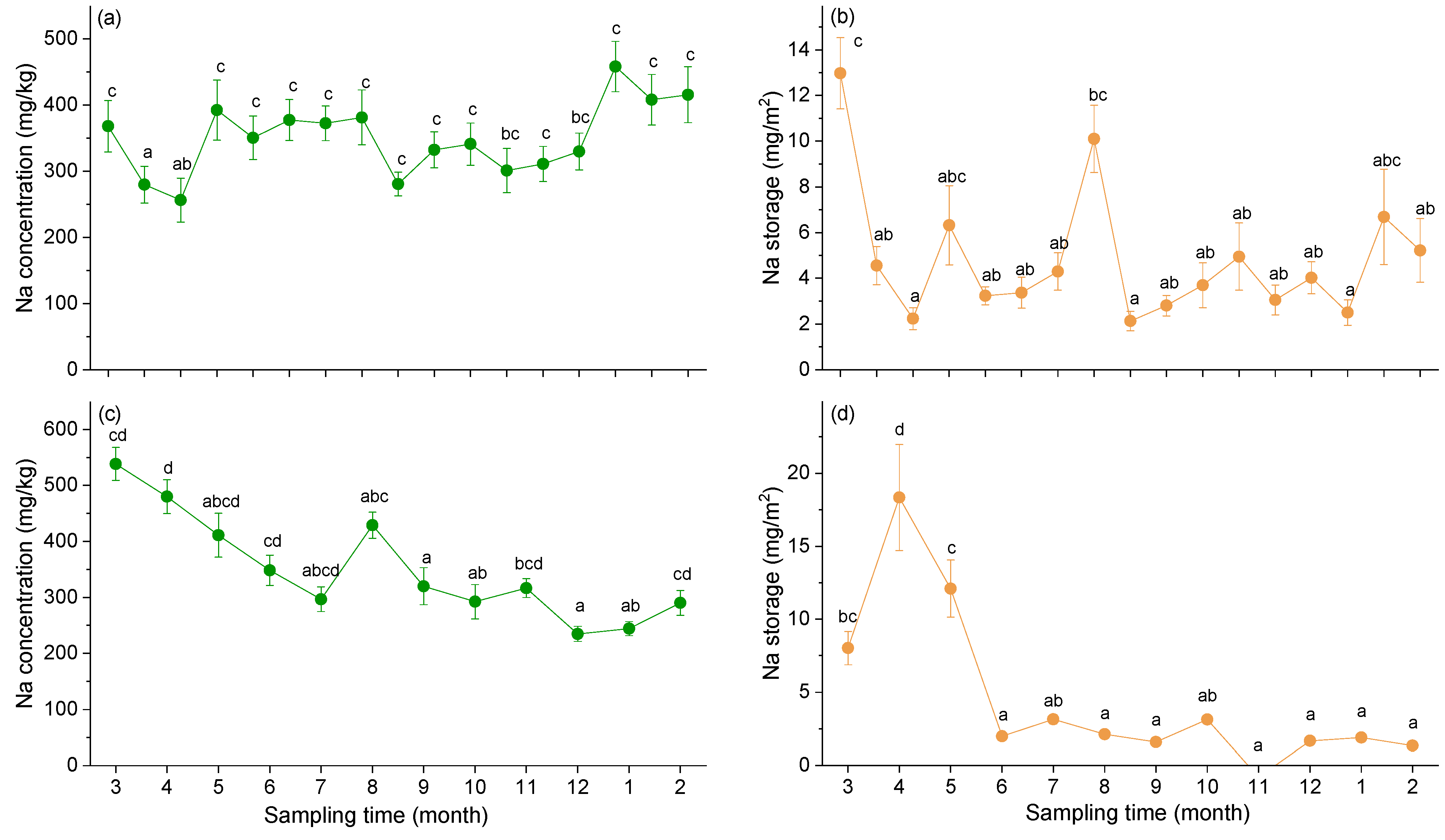
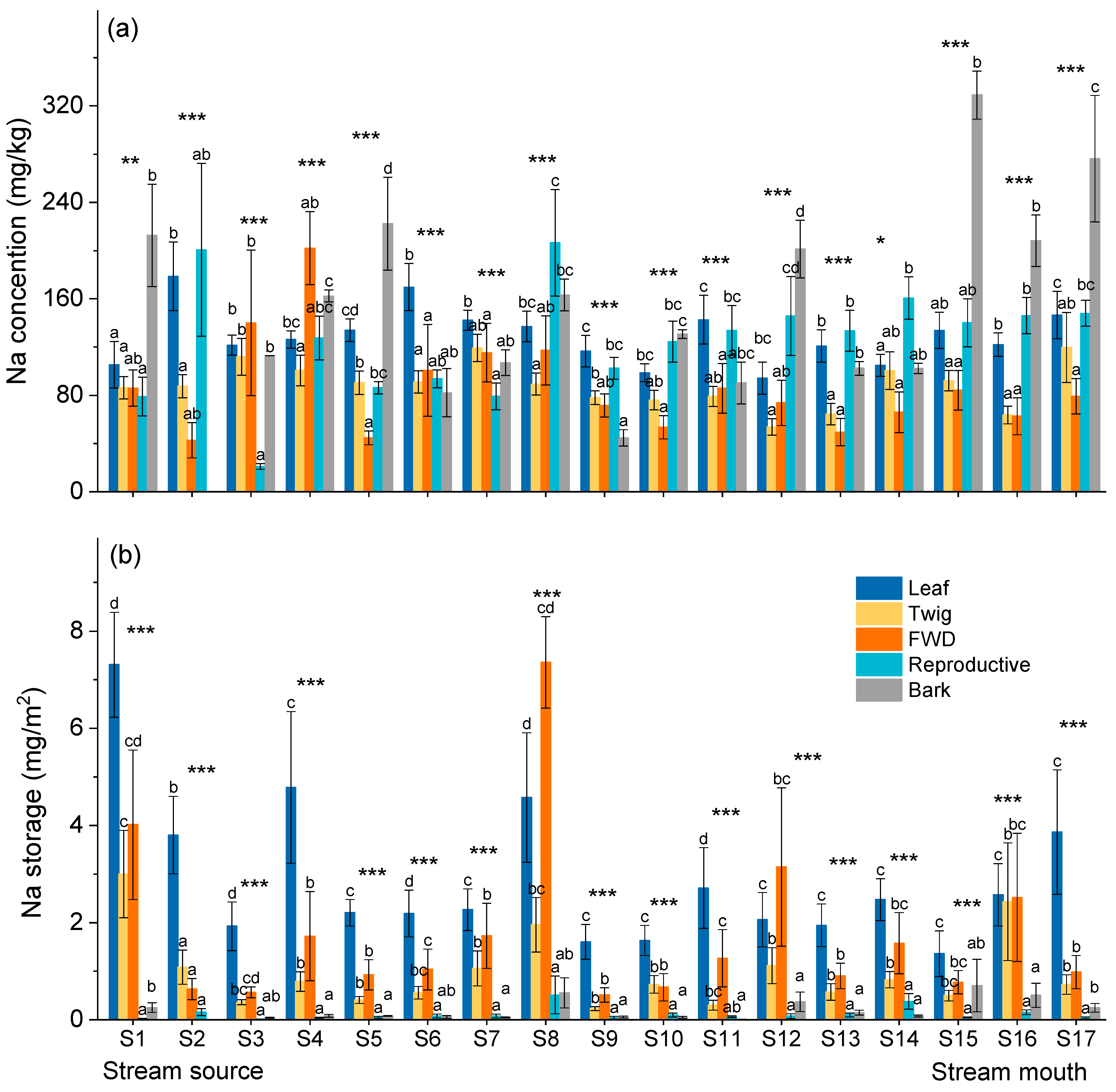

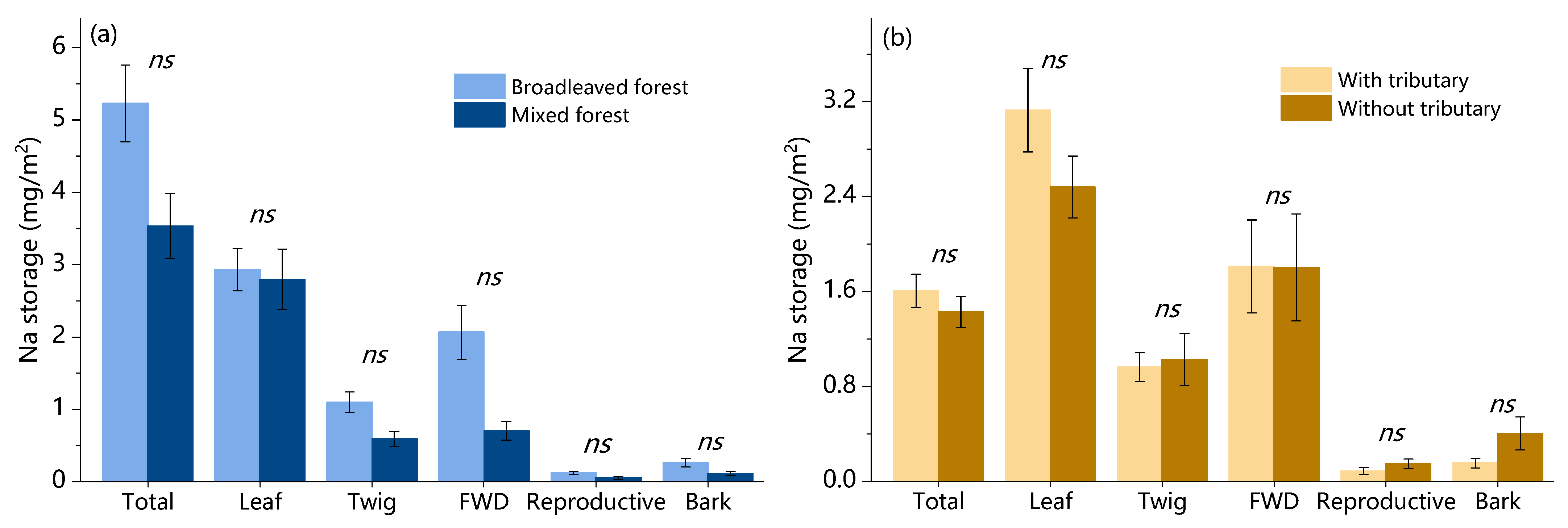
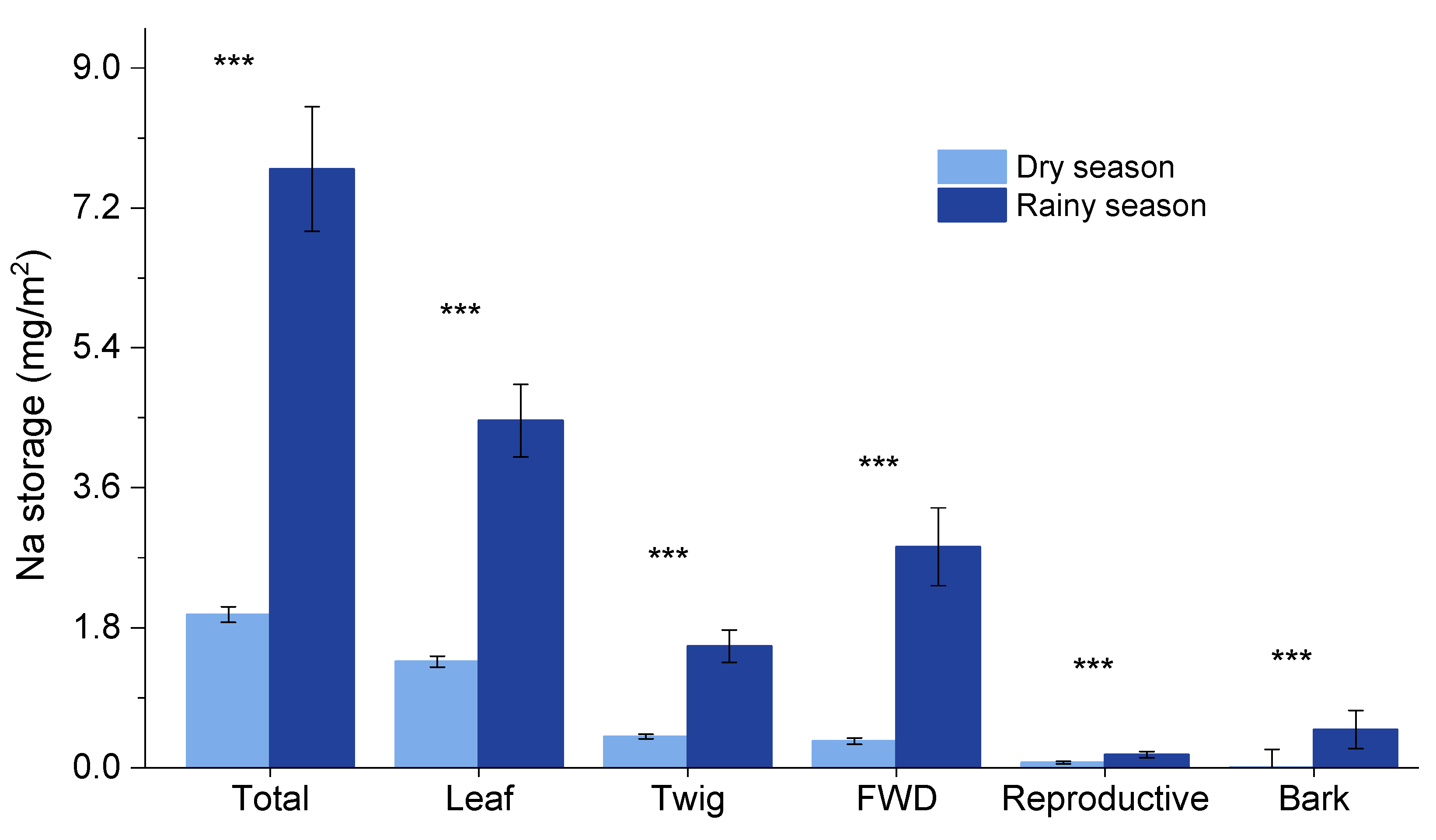
| Influence Factors | Leaf | Twig | FWD | RP | Bark | Total | ||||||
|---|---|---|---|---|---|---|---|---|---|---|---|---|
| Estimate | p | Estimate | p | Estimate | p | Estimate | p | Estimate | p | Estimate | p | |
| Rainfall amount | 0.001 | <0.05 | 0.001 | <0.001 | 0.001 | <0.001 | 0.001 | 0.144 | 0.000 | 0.202 | 0.034 | <0.001 |
| Water temperature (°C) | 0.003 | 0.057 | 0.009 | <0.001 | 0.001 | <0.001 | −0.011 | 0.600 | 0.008 | <0.01 | 0.159 | <0.01 |
| Discharge (L/s) | 0.028 | 0.474 | 0.075 | <0.001 | 0.142 | <0.001 | −0.014 | 0.333 | −0.028 | <0.05 | 1.657 | <0.05 |
| Flow velocity (m/s) | −0.006 | 0.163 | 0.362 | <0.001 | 0.380 | <0.001 | 0.432 | 0.117 | 0.847 | <0.01 | 0.424 | <0.001 |
| Active channel width (cm) | 0.054 | 0.678 | −0.242 | 0.455 | −0.152 | 0.251 | −0.819 | 0.433 | −0.563 | 0.467 | 2.258 | 0.753 |
| Water depth (cm) | 0.081 | 0.665 | −0.096 | 0.190 | −0.180 | <0.01 | −0.515 | 0.502 | −0.955 | 0.757 | 4.292 | 0.726 |
| Stream gradient (°) | 0.007 | 0.439 | −0.040 | 0.731 | −0.027 | 0.523 | −0.129 | 0.187 | −0.102 | 0.338 | 0.311 | <0.05 |
| Water pH | 0.011 | <0.001 | −0.075 | 0.392 | −0.047 | 0.676 | −0.254 | <0.01 | −0.178 | 0.545 | 0.644 | <0.05 |
| Dissolved oxygen (mg/L) | 0.116 | 0.507 | −0.577 | <0.001 | −0.388 | <0.01 | −1.663 | <0.05 | −1.265 | 0.616 | 4.416 | <0.05 |
| Electrical conductivity (μm/m) | −0.025 | 0.012 | 0.345 | 0.264 | 0.234 | 0.150 | 1.164 | 0.365 | 0.791 | 0.807 | −2.730 | 0.417 |
| Alkalinity (mg/L) | −0.020 | <0.001 | −0.020 | <0.001 | −0.010 | <0.01 | −0.071 | <0.001 | −0.044 | <0.05 | −0.202 | <0.001 |
Disclaimer/Publisher’s Note: The statements, opinions and data contained in all publications are solely those of the individual author(s) and contributor(s) and not of MDPI and/or the editor(s). MDPI and/or the editor(s) disclaim responsibility for any injury to people or property resulting from any ideas, methods, instructions or products referred to in the content. |
© 2025 by the authors. Licensee MDPI, Basel, Switzerland. This article is an open access article distributed under the terms and conditions of the Creative Commons Attribution (CC BY) license (https://creativecommons.org/licenses/by/4.0/).
Share and Cite
Zheng, Y.; Chen, S.; Peng, Y.; Zhao, Z.; Yuan, C.; Yuan, J.; An, N.; Ni, X.; Wu, F.; Yue, K. Dynamics of Plant Litter Sodium Storage in a Subtropical Forest Headwater Stream. Water 2025, 17, 1828. https://doi.org/10.3390/w17121828
Zheng Y, Chen S, Peng Y, Zhao Z, Yuan C, Yuan J, An N, Ni X, Wu F, Yue K. Dynamics of Plant Litter Sodium Storage in a Subtropical Forest Headwater Stream. Water. 2025; 17(12):1828. https://doi.org/10.3390/w17121828
Chicago/Turabian StyleZheng, Yuchen, Siying Chen, Yan Peng, Zemin Zhao, Chaoxiang Yuan, Ji Yuan, Nannan An, Xiangyin Ni, Fuzhong Wu, and Kai Yue. 2025. "Dynamics of Plant Litter Sodium Storage in a Subtropical Forest Headwater Stream" Water 17, no. 12: 1828. https://doi.org/10.3390/w17121828
APA StyleZheng, Y., Chen, S., Peng, Y., Zhao, Z., Yuan, C., Yuan, J., An, N., Ni, X., Wu, F., & Yue, K. (2025). Dynamics of Plant Litter Sodium Storage in a Subtropical Forest Headwater Stream. Water, 17(12), 1828. https://doi.org/10.3390/w17121828









